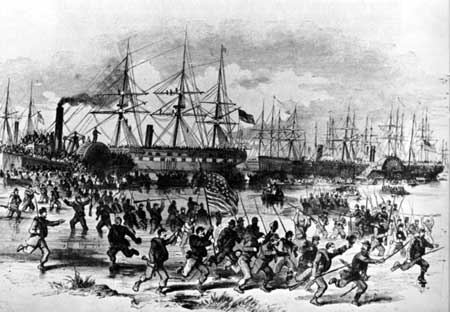|
FORT PULASKI National Monument |
 |

Federal troops land on Hilton Head Island, November 7, 1861.
Sketch by W. T. Crane in The Soldier in Our Civil War.
The Great Expedition
By midsummer, 1861, the North had already planned the strategy that led to the fall of Fort Pulaski. This plan included a naval blockade of the South and the recapture of the southern seacoast fortifications.
On October 29, a combined Army and Navy expedition sailed under sealed orders from Hampton Roads. The great convoy, composed of 51 vessels, moved out to sea in 3 columns—an impressive sight that foreshadowed the amphibious movements of World War II. Twenty-five colliers under gunboat escort had sailed the day before. Army forces numbering more than 12,500 men were under the command of Brig. Gen. Thomas W. Sherman, while the naval squadron and the convoy were commanded by Capt. Samuel F. Du Pont.
At destination, the invading troops were to land in three waves by means of surf boats capable of carrying from 70 to 100 men each. These boats were to approach the beach abreast in line of battle. Infantry, light artillery, and engineers with entrenching tools and sandbags were to go in on the first wave and were expected to overcome initial enemy resistance and dig in on the beach. Heavy field artillery would move in on the second wave and reserves on the third. As soon as the landing had been effected, all boats were to report to the chief quartermaster for unloading supplies.

Occupation of Tybee Island by Federal troops brings panic to
Savannah.
Contemporary sketch from The Soldier in Our Civil
War.
This plan of battle was never executed, for a few days after sailing the expedition ran into a terrific storm off Cape Hatteras. Several vessels and many of the landing craft were lost. Thus handicapped, General Sherman might have had grave difficulty in securing the beachhead. When the convoy finally reassembled off Port Royal Sound, S. C., the Navy took the initiative. On November 7, Flag Officer Du Pont led his squadron of steam-propelled vessels to the entrance of the sound where he formed a great oval between the two Confederate forts on Hilton Head and Bay Point. Steaming continuously each vessel fired a broadside as it came opposite one of the forts. So punishing was the effect of this naval bombardment that the Confederates abandoned both fortifications, and the landings on Hilton Head and Bay Point were unopposed. A few days after this initial battle, the town of Port Royal on the mainland fell to the expeditionary force. From these vantage points within sight of Cockspur Island, the Federal troops were made ready to strike at Fort Pulaski.

|

|
|
Last Modified: Mon, Mar 4 2002 10:00:00 pm PDT |


